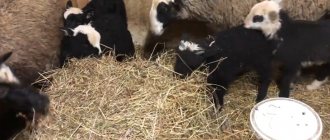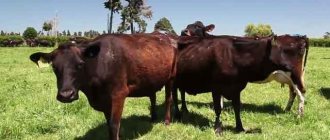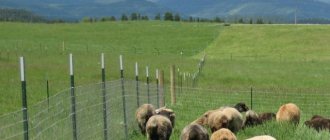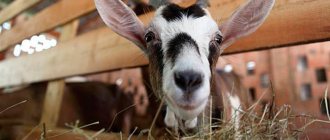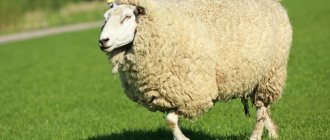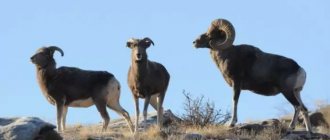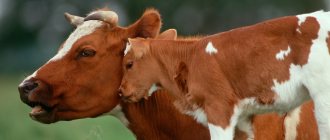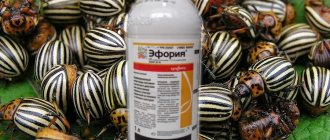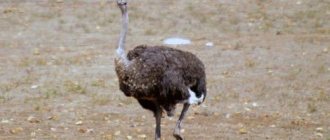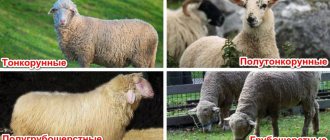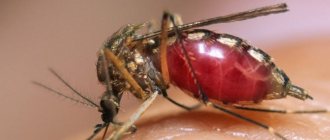Timing and organization of pasture use
How to use pasture rationally:
- analyze grass yields;
- calculate the timing of plants being eaten by animals;
- determine the permissible number of individuals per hectare of area.
The time of pasture use is limited by the maturation and restoration of grass cover. To prevent animals from trampling down the grass too quickly, the area is divided into squares and portable fences are installed. When the sheep eat the grass in one area, the partitions are moved to the next square and the animals are transferred there. The grass cover is restored within a month. Therefore, the flock is allowed into the first area no earlier than this time. The area of the plots is calculated so that the herd has enough food for a week.
Grazing rules
Animals are gradually transferred from confinement to grazing on pasture.
Preparation
A sharp transition from winter keeping in a barn to grazing causes digestive upset in sheep. Therefore, the flock is prepared according to the following rules:
- released to graze for an hour in the afternoon;
- before grazing they are fed with hay;
- upon returning to the barn, they give plenty of water.
General preparation rules:
- conduct a veterinary examination of animals, vaccination against ticks, parasites and infections;
- trim the hair on the hooves and around the eyes;
- divide the herd into flocks based on age and wool quality.
The pasture is preliminarily inspected, places for rest and grazing are designated, and a movement schedule is drawn up.
Schedule
Sheep are released to pasture in late spring - in the middle or end of May, depending on the climate. At the beginning of the month, the grass is not yet tall enough and nutritious.
Grazing begins at dawn. Approximate schedule:
| Time | Action | Description |
| 05:00 | The flock is driven out to pasture | Early in the morning it is not hot and there are no blood-sucking insects. |
| 11:00-12:00 | Sheep are driven into the shade, to the river for an afternoon rest | The daytime crossing begins earlier on particularly hot days. If the weather is cool and cloudy, the herd is not moved or grazed until noon |
| 15:00 | The herd is taken out to pasture | The heat is subsiding |
| 20:00-21:00 | Otaru is taken home | In summer, the herd can stay in the meadow longer |
During spring grazing, sheep are turned out to the legume area after the morning dew has subsided and before the evening dew falls. Young moist stems ferment in the stomachs of animals, and as a result, the disease tympania develops.
Features of summer grazing:
- early arrival due to dew;
- moving to the shade to chew grass;
- night grazing.
Animals are brought to the field at 18:00. They feed until one in the morning, rest for two hours and feed again until ten or eleven in the morning. During the day, the herd rests in the sheepfold. In summer, dew softens grains and helps them digest better. But you should not graze your flock on wet alfalfa.
During winter grazing, the herd is released to pasture at 11 am. Covered parking lots with a supply of hay and water are equipped on the territory. In case of bad weather, animals are driven under shelters. Sheep farming uses grazing methods without a shepherd. Animals are kept in open pens with electric current running through the fences. Low voltage is safe for the ram, ewe and lamb, but will prevent the herd from scattering around the area.
See also
Top 5 dairy sheep breeds and their main indicators, industry development in RussiaRead
Organization of a watering place
In summer, sheep find it more difficult to tolerate thirst than hunger. On hot days, animals are given water three times a day. In autumn, the number of trips to watering places is reduced to two times. On particularly cool days, sheep are given water once a day.
The maximum distance a herd can travel is 3 kilometers. If the reservoir is located further away, water is transported to the pasture. Sheep that travel long distances every day gain weight worse.
Sheep Resources
Before getting involved in the development of sheep farming, it is necessary to assess your own resources for this type of activity.
- Sheep farming is a business, so before you start it, you need to study the business from different aspects.
- Sheep will require care, so it is important to have the time and physical strength to do the work.
- An important resource is the nutrition of sheep; it is important to decide what the sheep will eat - natural or purchased food.
- It is necessary to prepare good pens and fences for sheep, the height of which should be appropriate, since sheep can jump high.
- It is necessary to prepare a water supply, water tanks, hay containers and shields of different sizes.
- Each sheep needs to be allocated 15 to 25 square meters of space in the pen.
Tips and tricks
How to start herding sheep:
- during the first grazing, do not move frequently from one place to another, so as not to disturb;
- young animals and breeding stock are brought to the best lands;
- graze in a deployed formation so as not to trample the area;
- When choosing terrain, give preference to areas with a high content of white clover and timothy.
In summer, sites should be changed every 12 days to reduce the likelihood of infection with worms and parasitic blow flies;
Features of sheep farming technology
Sheep farming technology includes types of products, rules for keeping and caring for sheep, reproduction of the herd and other aspects.
Types of sheep products are as follows:
- Wool products. It is valued for its properties - it retains heat and moisture, transmits ultraviolet rays, and has a long service life;
- Sheepskin and smushka. Fur, fur and leather sheepskins;
- Meat products. Lamb is highly prized and has excellent nutritional properties;
- Milk products. Sheep milk is a very valuable product from which I make cheese, feta cheese and other dairy products;
Sheep farming technology also includes the following:
- Herd reproduction
- Raising young animals
- Keeping and feeding sheep
Pedigree sheep breeding
Pedigree sheep farming includes breeding work with purebred sheep for breeding herds of the same type. Many farmers are of the opinion that sheep breeding should be purebred, believing that crossbreds do not always give effective results.
Today, sheep breeders are restoring fine-fleece and semi-fine-fleece breeds, as demand for their wool is increasing.
The presence of breeding status gives sheep farmers the opportunity to receive significant profits from the sale of young stock. The genetic pool of purebred sheep is preserved by raising herds, where breeding rams are especially valued. It is young animals of pure breed that are the main value of this type of sheep breeding.
Meat sheep farming
Sheep farming for meat has always attracted increased interest. The advantage of meat sheep breeding is that such breeds of sheep are unpretentious, fertile and have high early maturity.
Meat sheep quickly recoup the investment and generate net income. The most advantageous age for lambs is up to eight months; such meat is considered a very valuable product and is not inferior to beef in nutritional values. Meat sheep accumulate fat reserves well and constantly increase live weight.
Common meat breeds include:
- North Caucasian breed;
- Gorkovskaya;
- Romanovskaya;
- Gissarska and many others.
What difficulties may arise
Before you start grazing you need to know that:
- spring grass contains a lot of potassium. Sheep suffer from convulsions from excess of the substance. Excess potassium is balanced with sodium, which is contained in salt. The daily norm for an adult animal in the spring is 10 grams;
- hatching on alfalfa is alternated with feeding on natural pasture. The stems of the plant are covered in the stomach with ordinary herbs and are better absorbed;
- Not all clover is good for sheep. A plant with red flowers in the first year of growth contains a nerve poison. Sheep are allowed into the red clover field after harvesting in the second year;
- The sheep huddle tightly together and keep each other warm. The herd instinct is useful in winter, but dangerous in summer. Animals must be separated to prevent heatstroke.
The health and fatness of the sheep depend on the skill of the shepherd. An experienced shepherd understands useful and harmful herbs and determines the duration of grazing based on the weather.
Possible diseases
To prevent lambs from getting sick, it is necessary to adhere to the basic rules of sanitation, treat the premises in which a sick animal was noticed with special substances, about which it is better to consult a veterinarian. Sick animals should be separated from others and should not be allowed to come into contact with healthy animals.
1.
Diseases are not contagious
- Nutritional imbalance. Lambs may lack some minerals, and as a result, they begin to eat wool from other lambs. After this, they die because the abomasum (part of the stomach in ruminants) becomes blocked. A lack of phosphorus and calcium can cause rickets, and in adults – osteoporosis.
- Cold. One of the main enemies is dampness. It should be avoided in every possible way, both in winter and summer. Animals get sick from it. Colds may appear if they are exposed to rain, since wet wool cannot dry for a long time, and everyone will get sick.
- Poisoning. They can be poisoned by low-quality feed, some herbs, and excessive amounts of sugar beets.
- Wounds, fractures, bruises, mastitis in the uterus. In the summer, flies and other blood-sucking insects (horseflies, gadflies) lay their eggs in any wound, from which larvae grow. They begin to corrode the skin, causing the animals to experience pain and itching, and they are no longer interested in grazing. These larvae are removed and the wounds are lubricated with iodine or another disinfectant solution. It is best to lubricate wounds on the same day; for this, animals need to be examined more often for their appearance.
2.
Contagious diseases
- Scabies
- Brucellosis
- Coccidiosis
- Worms. To avoid infecting your animals with worms, you need to graze them in a new place every week.
In all cases of malaise, which is expressed in lethargy, poor appetite, you should immediately contact a veterinarian.
And we should never forget that sheep are the most defenseless animals; a wolf or a large dog can not only frighten them, as a result of which the ewes may lose milk, but also destroy an entire flock, as has happened more than once.
Sheep grazing rate per 1 ha
The rate of grass consumption depends on the type of pasture and the number of sheep.
To calculate how many animals should graze on one hectare of field, use the following formula:
G = U / N x P
Formula variables mean:
- G - number of sheep;
- Y is the yield per hectare multiplied by the percentage of pasture use;
- N is the amount of green mass that sheep eat during grazing;
- P is the period of use of pasture.
Natural lands are used by 60 percent, and artificial ones by 90. Grazing lasts 6 hours without taking into account the midday rest. One sheep eats 2 kilograms of greens per hour or 12 kilograms per day on grazing.
